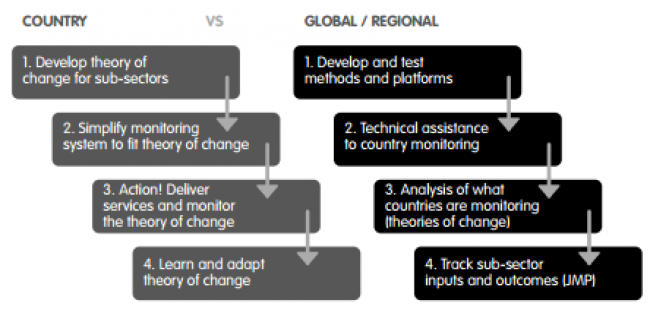Even though the global system of water, sanitation, and hygiene (WASH) monitoring lacks coherence, the small steps being made give reason for optimism.
Published on: 11/03/2014

Monitoring in the WASH sector is crowded and poorly coordinated and there is little consistency or quality control of sector data
The water, sanitation, and hygiene (WASH) sector is experiencing strong demand for better data and good analysis. This desire is fuelled by: a focus on measurable results from aid; the competition for resources (requiring detailed evidence of inputs, outputs, outcomes, and impacts); the increasing complexity of WASH issues; the multiplicity of and growth in sector agencies; growing links with other sectors (such as climate change, human rights, water resource management, and health); a desire to achieve better value for money from WASH investments; and better information and communication technology (ICT), which provides easier data collection and new opportunities to use data.
At the same time, the global system of WASH monitoring lacks coherence. There are large numbers of monitoring initiatives, yet there are major gaps in data collection, analysis, and reporting.
Despite the enormity of the challenge, there is reason for optimism. Small steps are being made and new ideas are emerging to improve the coherence and overall architecture of WASH monitoring.
Greater cohesion and collaboration [would be achieved] by one global agency undertaking sector monitoring and one global agency to take on a regulatory function.
Key monitoring initiatives at the global level include the UNICEF/World HWHO) Joint Monitoring Programme (JMP), which measures outputs, and the UN-Water Global Analysis and Assessment of Sanitation and Drinking Water (GLAAS), which measures inputs.
Another important global database that collects data from water utilities, but is not fully integrated into the global monitoring framework, is the International Benchmarking Network for Water and Sanitation (IBNET) managed by the World Bank.
These global networks have made significant advances and are well positioned to adapt to the post-millennium development goal environment; they should align with global accountability frameworks, such as the political accountability being built into Sanitation and Water for All (SWA).
At a regional level, regional sanitation meetings (AfricaSan for Africa, LatinoSan for Latin America, EASAN for East Asia, and the South Asian Conference on Sanitation (SACOSAN)), which were initiated with the first AfricaSan meeting in 2002, are evolving in different ways and at different paces into regional advocacy and monitoring processes to track the implementation of action plans and commitments (such as the Ngor declaration).
Regional political bodies such as the African Union (AU), the African Ministers’ Council on Water (AMCOW) and, in South Asia, the South Asian Association for Regional Cooperation (SAARC) have also initiated regional monitoring activities in the water and sanitation sector.
Most countries undertake national monitoring, but its effectiveness varies considerably. A key problem in national sector data is that service provider data often differs from user data (from household surveys). This hinders the understanding of the state of the sector and, as a result, the design of effective policies and interventions. A number of agencies have developed analytical tools for the WASH sector but generic approaches have not been agreed.
The above text has been taken from:
Cross, P., 2015. Small steps towards building national-regional-global coherence in monitoring WASH. In: Schouten, T. & Smits, S. From infrastructure to services : trends in monitoring sustainable water, sanitation and hygiene services. Rugby, UK: IRC and Practical Action, P. 137-155